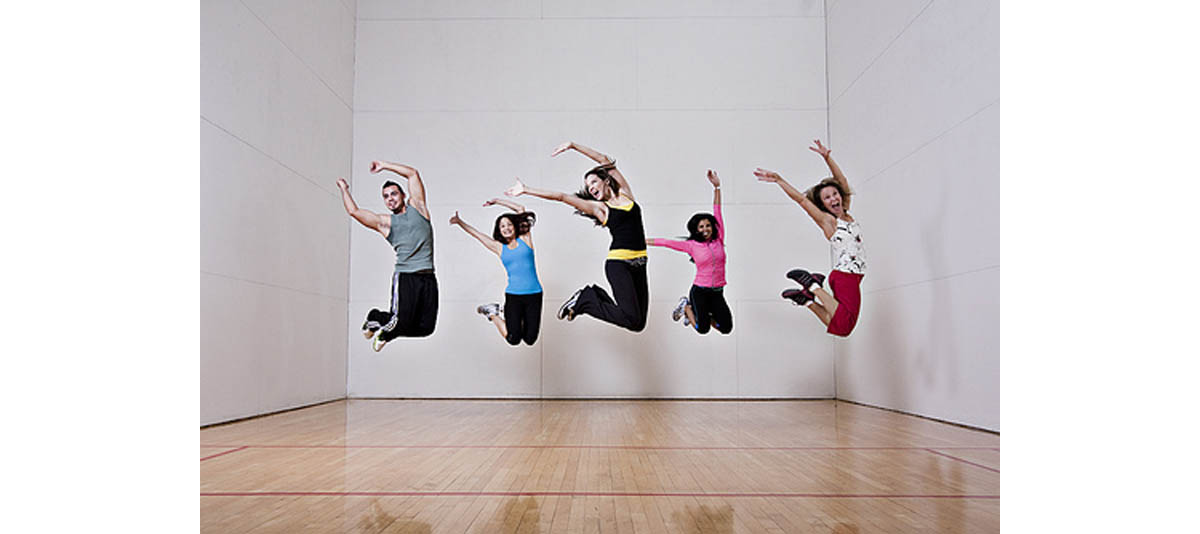Table of Contents
Zumba is often described a combination of gym class and dance party. It is a great way to burn calories and build agility, but without an appropriate warmup, muscle cramps, pulled hamstrings, and ankle injuries are all too common in Zumba classes
Zumba is often described as fast and frenzied. It's not for everyone.
If you have a cardiovascular condition, if you are pregnant, if you have lung disease or diabetes or some other metabolic condition, you probably should not do the traditional Zumba, although Zumba Gold might be fine—check with your doctor first.
However, if you are otherwise in good health, here are the three simple steps to preventing the pulled hamstrings, sprained ankles, and lower back pain that can occur among beginners to the Zumba approach to health and fitness.
Zumba does not require any fancy equipment, but health regulations will require you to wear shoes. Don't wear running shoes.
Running shoes have tread on their soles to make forward motion easier. Since Zumba involves quick movements backwards and to the left and right, the tread on running shoes makes injuries more likely. It is better to wear thin-soled sneakers or comfortable gym shoes, just not running shoes.
There is some debate over whether athletes really need to do stretches before working out. The American College of Sports Medicine and the European College of Sport Sciences go so far as to state that stretching before an athletic competition may even lower performance of well-trained athletes.
Most people doing Zumba, however, are not well-trained athletes. Many people doing the exercise routine haven't been doing any other exercise at all.
Ask your instructor to show you how to do stretches—and if they can't tell you, you need a different Zumba instructor! At the very least, simply move in place to step to the side to learn complicated dance steps, participating in the spirit of Zumba before plunging into a dance routine. When you can dance the steps with confidence, you'll burn more calories and build more muscle without risk of injuries that will put you on the sidelines.
If you have a cardiovascular condition, if you are pregnant, if you have lung disease or diabetes or some other metabolic condition, you probably should not do the traditional Zumba, although Zumba Gold might be fine—check with your doctor first.
However, if you are otherwise in good health, here are the three simple steps to preventing the pulled hamstrings, sprained ankles, and lower back pain that can occur among beginners to the Zumba approach to health and fitness.
1. Choose the right shoes

Running shoes have tread on their soles to make forward motion easier. Since Zumba involves quick movements backwards and to the left and right, the tread on running shoes makes injuries more likely. It is better to wear thin-soled sneakers or comfortable gym shoes, just not running shoes.
2. Choose a small class conducted in a spacious classroom
It is important for you to be able to see your Zumba instructor and for your Zumba instructor to be able to see you. If there are, for instance, 100 people in your class, your instructor will not be able to tell you how to make moves properly for maximum muscle strength and minimum risk of injury. An optimal class size is limited to about 25 participants if there is one instructor teaching and one instructor walking around to give individualized help, or about 10 participants if there is just one instructor. It is also important that your classroom is large enough to permit every participant to dance without colliding with other learners.3. Warm up before you start up
Zumba usually starts fast and ends fast. If your instructor doesn't guide your class in how to do stretches for your abdomen, calves, and hamstrings, you must do these on your own before the class begins.There is some debate over whether athletes really need to do stretches before working out. The American College of Sports Medicine and the European College of Sport Sciences go so far as to state that stretching before an athletic competition may even lower performance of well-trained athletes.
Most people doing Zumba, however, are not well-trained athletes. Many people doing the exercise routine haven't been doing any other exercise at all.
Ask your instructor to show you how to do stretches—and if they can't tell you, you need a different Zumba instructor! At the very least, simply move in place to step to the side to learn complicated dance steps, participating in the spirit of Zumba before plunging into a dance routine. When you can dance the steps with confidence, you'll burn more calories and build more muscle without risk of injuries that will put you on the sidelines.
- Bailey BW, McInnis K. Energy cost of exergaming: a comparison of the energy cost of 6 forms of exergaming. Arch Pediatr Adolesc Med. 2011 Jul, 165(7):597-602. Epub 2011 Mar 7.
- Kattenstroth JC, Kolankowska I, Kalisch T, Dinse HR. Superior sensory, motor, and cognitive performance in elderly individuals with multi-year dancing activities. Front Aging Neurosci. 2010 Jul 21, 2. pii: 31.
- Photo courtesy of anujraj on Flickr: www.flickr.com/photos/anujraj/5605689162/
- Photo courtesy of Edson Hong on Flickr: www.flickr.com/photos/edsonhong1/5242124138/

